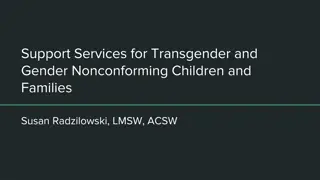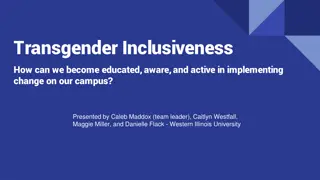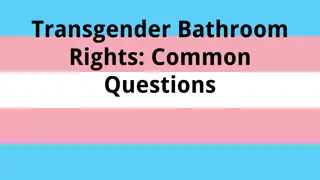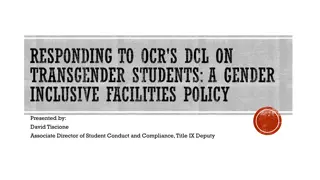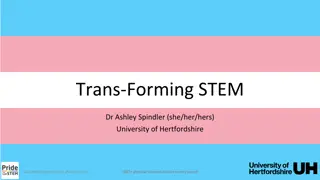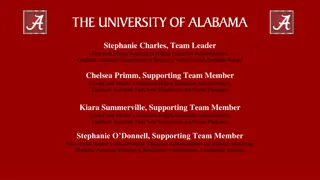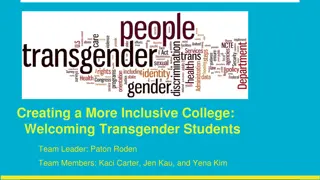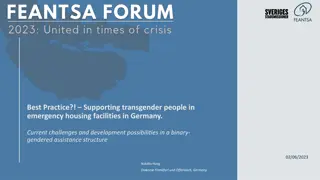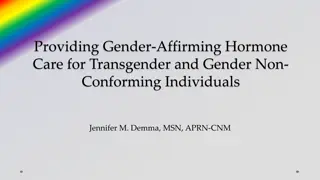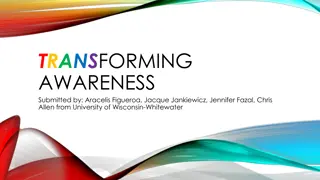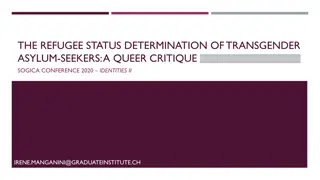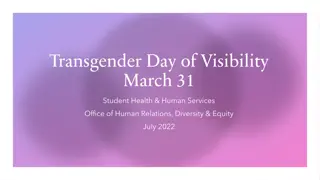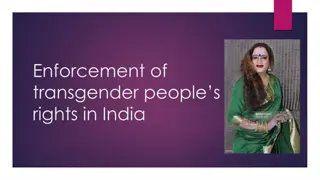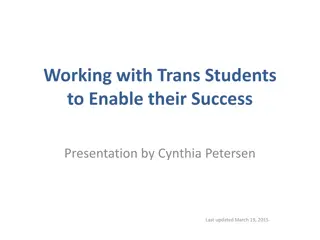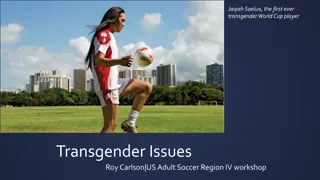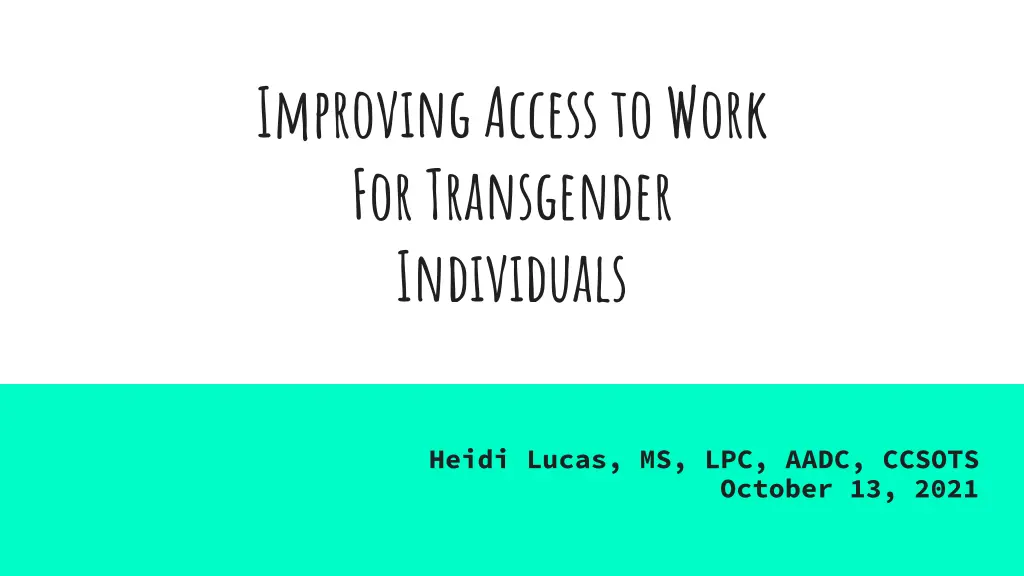
Improving Access to Work for Transgender Individuals - Overcoming Biases and Promoting Inclusivity
Explore strategies to address personal biases towards LGBTQ+ communities, increase awareness on LGBTQ+ issues, and enhance transgender-affirming access to work. Discover definitions and basics of gender identity, gender expression, and sexual orientation. Uncover barriers hindering acceptance and learn about different attractions and identities within the LGBTQ+ spectrum.
Download Presentation

Please find below an Image/Link to download the presentation.
The content on the website is provided AS IS for your information and personal use only. It may not be sold, licensed, or shared on other websites without obtaining consent from the author. If you encounter any issues during the download, it is possible that the publisher has removed the file from their server.
You are allowed to download the files provided on this website for personal or commercial use, subject to the condition that they are used lawfully. All files are the property of their respective owners.
The content on the website is provided AS IS for your information and personal use only. It may not be sold, licensed, or shared on other websites without obtaining consent from the author.
E N D
Presentation Transcript
Improving Access to Work For Transgender Individuals Heidi Lucas, MS, LPC, AADC, CCSOTS October 13, 2021
PURPOSE Identifying and decreasing personal biases toward LGBTQ+ communities, while increasing awareness about LGBTQ+ issues and improving transgender affirming access to work throughout the community, starting with Human Resources departments.
BARRIERS 1 Let s look at personal barriers that can impede acceptance of the LGBTQ+ community. Self-diagnosis is the first step toward getting the right step toward change. Spend some time considering why you might feel some discomfort. Common reactions can include: This just isn t what I was brought up to accept. Are people going to start thinking that I am gay? Will being okay with gay/transgender issues lead to conflict with others? This is much too political for me. How will this influence my relationship with the people I work with? I just don t know enough and I don t want to say the wrong thing or give incorrect information its just easier to keep my mouth closed. I don t want to be known as the provider with the reputation for having the gay/transgender workplace. Aren t people who are transgender just crossdressers anyway?
BASICS 1, 5 Gender Identity - The gender an individual identifies as psychologically regardless of what gender they were assigned at birth. Gender Expression - How someone expresses their gender through appearance, behavior or mannerisms. A person s gender expression may or may not be analogous to their gender identity. Sexual Orientation - Refers to a person s emotional, romantic, or sexual feelings toward people of the same or different sex/gender or irrespective of sex/gender.
ATTRACTION 1, 5 Gay - A term used to describe a male-identified person who is attracted to and may form sexual and romantic relationships with another male-identified person. Often gay is used to describe both men and women who partner with the same-sex; this is not universally preferred. Personal preference usually determines how one would like to identify their sexuality. Lesbian - A term to describe a female-identified person who is attracted to and may form sexual and romantic relationships with another female-identified person. Often lesbians are incorporated into the term gay; which may be used to describe both men and women who partner with same-sex. This is not universally preferred. Personal preference usually determines how one would like to identify their sexuality. Bisexual - A term used to describe someone who is attracted to and may form sexual and romantic relationships with someone
IDENTITY 1,5 Cisgender - A preferred term to refer to someone whose gender identity matches their assigned gender at birth. It is contrasted to transgender when that term is used to refer to someone whose gender identify does NOT match their assigned gender at birth. The origin of the term is logically based on the Latin prefixes, in which cis ( on the same side ) is the opposite of trans ( on the opposite side ). Transgender - A broad term that refers to people who experience their gender identity or express their gender in ways that do not conform to their assigned sex at birth. Transgender individuals may pursue hormone therapy and/or gender affirmation surgeries through a process called transitioning. A person who identifies as transgender may be heterosexual, gay, lesbian, bisexual, queer, asexual; they are not always a sexual minority. Non-Binary - A person who identifies outside of the margins of either male or female. Intersex - A general term used to refer to individuals born with or who
OTHER TERMS 1,5 Gender Dysphoria - A term coined by psychologists and medical doctors that refers to the state of discomfort felt by some transgender people caused by the incongruity between one s physical sex and one s gender identity. Gender Affirmation Surgery - Any surgery that someone has in the course of their transition from male to female or female to male. It may also be performed on people with an intersex condition (or Disorders for Sex Development), often in infancy. There are many different gender affirmation surgeries. The term does not always refer to bottom surgery. So if a patient says that a person had gender affirming surgery, don t make assumptions about the procedure(s) performed. Hormone Replacement Therapy (HRT) - Many transgender people take hormones as part of their transition, either from male to female or female to male. However some transgender people do not take
OTHER TERMS (cont) 1,5 Out - Describes people who identify as gay, lesbian, bisexual, or transgender in their public and/or professional lives. Closeted - Describes a person who is not open about their sexual orientation or gender identity publicly.
IMPACT OF DISCRIMINATION -SUICIDE RATES 2 Prevalence of suicide thoughts and attempts among transgender adults is significantly higher than that of the general population Transgender adults who experienced discrimination or were victims of violence were more likely to report suicidal thoughts and attempts 98% of respondents who experienced 4 instances of discriminstion and violence in the past year thought about suicide that year 51% of them attempted suicide that year
IMPACT OF DISCRIMINATION -SUICIDE RATES 41% of transgender people surveyed had attempted suicide at some point of time in their lives 3 Suicide attempts for urban cisgender youth=14.6%, suicide attempts for urband transgender youth=34.6% 4 1.7 million adults identify as transgender as of 5/11/21. This does not include youth. 1
DISCRIMINATION IN THE WORKPLACE 90% of transgender workers reported workplace minstreatment or discrimination 8 26% reported lost work due to the mistreatment or discrimination 8 Other factors that individuals who are transgender said they dealt with on a daily basis included: Being a target of transphobic remarks, being ignored, being pressured to act in traditionally gendered ways, predatory behavior, harassment, and rumors. 7 Feeling unsupported by administration, diminished job satisfaction, emotional exhaustion, rumination, having to be
RESILIENCY IN THE WORKPLACE -THE LAW (Title VII) As simple as this seems, following the federal law has a lasting effect. Four simple steps can help transgender people in the workplace. 6, 7 1. Trandgender employees must be allowed access to the bathroom of their gender identity. This cannot include restricting the individual to a single-user bathroom or requiring a bathroom that is unreasonably long distance away from their workstation. 2. Apply and enforce dress codes consistently for appropriate genders. Once an employee comes out, that employee will be required to adhere to the dress code for that gender; however consider not requiring conforming to specific gender related dress and appearance policies for all personnel. 3. Use the employee s preferred name and pronouns. 4. Update your company s non-discrimination policies to specifically include people who are transgender
GOING ABOVE AND BEYOND THE LAW 7 5. Support Gender Transitions 6. Help your transitioning employees access health care and ensure they can get is as medically necessary 7. Develop transgender-specific diversity training for your company
References 1 Straight for Equality in Healthcare, 2009, PFLAG, June 18, 2001. https://straightforequality.org/sites/default/files/Read%this%20Before%2 0you%20out%20your%20Metatarsals%20Between%20your%20Mandible%20and%20Maxi lla.pdf. 2 UCLA. School of Williams Institute, September 2019. https://williamsinstitute.law.ucla.edu/publications/suicidaility- transgender-adults/ 3 The Power of 41%: A Glimpse into the Life of a Statistic. 2016; 86 (4) 383-7. 4 Transgender Identity and Experience of Violence Victimization, Substance Use, Suicide Risk, and Sexual Risk Behaviors Among High School Students-19 States and Large Urban School Districts, 2017. Johns, et. al. US Department of Health and Human Services/CDC Prevention, MMWR, January 25, 2019. Vol. 68, No. 3. 5 Definitions for LGBTIQA Related Terms. UNC Chapel Hill Safe Zone. July
References 6 Transgender Employees: Six Recommendations for Employers. 2016. Reinhart Law. October 10, 2021. https://www.reinhartlaw.com/knowledge/transgender-employees- six-recommendations-employers/Reinhartlaw.com 7 Creating a Trans-Inclusive Workplace. March-April 2020. Harvard Business Review. October 10, 2021. https://hbr.org/2020/03/creating-a-trans-inclusive-workplace 8 Transgender Workplace Rights. Lambda Legal. October 10, 2021. https://www.lambdalegal.org/know-your- rights/article/trans-workplace

